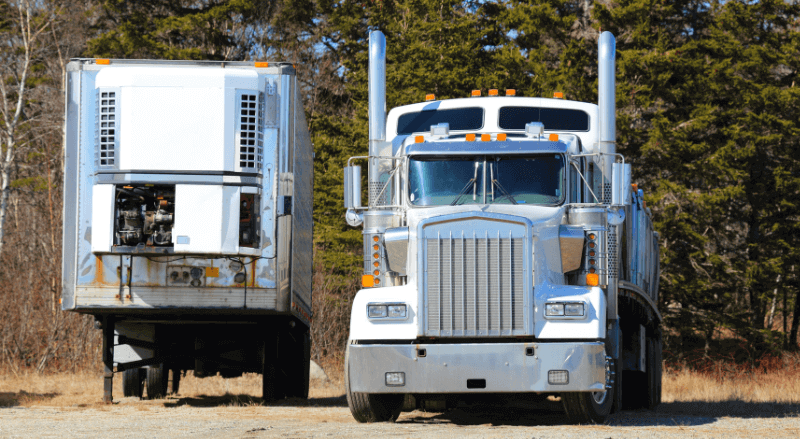Have you ever wondered how much your truck and trailer weigh together? It’s important to know the weight of your rig when you’re driving, especially if you’re planning on towing a heavy load. Have you ever wondered how much your truck and trailer weigh together? It’s important to know the weight of your rig when you’re driving, especially if you’re planning on towing a heavy load.
In this blog post, we’ll show you how to calculate the GVWR of your truck and trailer. We’ll also explain what GVWR is and why it’s important to stay within its limits. Stay safe on the road by knowing the weight of your vehicle!
What is GVWR and what does it stand for?
GVWR is the acronym for “Gross Vehicle Weight Rating.” This is the maximum recommended weight of a vehicle, including passengers, cargo, and all other items that may be added to the vehicle.
The GVWR is typically listed on a sticker or plate located on the inside of the driver’s door. Exceeding the GVWR can result in damage to the vehicle and potentially dangerous driving conditions. It is important to know the GVWR of your vehicle and to make sure that you do not exceed it when loading up your vehicle for a trip.
Overloading a vehicle beyond its GVWR can cause problems with steering, braking, and acceleration. It can also lead to tire failure and put stress on other parts of the vehicle, which can shorten its overall lifespan.
If you are unsure of your vehicle’s GVWR, be sure to check the owner’s manual or contact the manufacturer. It is always better to err on the side of caution when it comes to your vehicle’s weight limit.
How to Calculate the GVWR of a Truck & Trailer?
To calculate the GVWR of a truck and trailer, you will need to add together the empty weight of the truck, the maximum payload capacity of the truck, and the trailer’s maximum loaded weight.

We calculate the GVWR according to this formula:
Tare Weight + Rated Payload = GVWR
For example, if you have a truck with an empty weight of 6,000 pounds and a payload capacity of 2,000 pounds then your total GVWR would be 8,000 pounds.
This is just an example – be sure to consult your specific vehicle’s owner’s manual or contact the manufacturer to get the most accurate GVWR for your particular truck and trailer combination.
Factors that Impact on the GVWR calculation
There are a few different factors that can impact the GVWR calculation for a truck and trailer. These include:
- The type of truck being used: Some trucks have higher payload capacities than others. For example, a one-ton truck will have a higher payload capacity than a half-ton truck.
- The type of trailer being used: The size and weight of the trailer will impact the GVWR calculation. A larger or heavier trailer will result in a higher GVWR.
- The number of axles on the trailer: The more axles a trailer has, the higher its GVWR will be. This is because each axle can support a certain amount of weight.
- The type of cargo being carried: The weight of the cargo will impact the GVWR calculation. Heavier cargo will result in a higher GVWR.
These are just a few examples of factors that can impact the GVWR calculation for a truck and trailer. Be sure to consult your specific vehicle’s owner’s manual or contact the manufacturer to get the most accurate GVWR for your particular truck and trailer combination.
Examples of How to Use the GVWR Calculation Formula
Example # 1
Let’s say you have a truck with an empty weight of 6,000 pounds and a payload capacity of 2,000 pounds. You want to know what the GVWR would be if you added a trailer with a maximum loaded weight of 4,000 pounds.
To calculate this, we would use the formula:
Tare Weight + Rated Payload = GVWR
In this example, the tare weight is the empty weight of the truck (6,000 pounds) and the rated payload is the payload capacity of the truck (2,000 pounds).
When we plug these numbers into the formula, we get:
6,000 + 2,000 = 8,000
This means that the GVWR of the truck and trailer combination would be 8,000 pounds.
Example # 2
Now let’s say you have a different truck with an empty weight of 6,500 pounds and a payload capacity of 1,500 pounds. You want to know what the GVWR would be if you added the same trailer with a maximum loaded weight of 4,000 pounds.
To calculate this, we would use the same formula:
Tare Weight + Rated Payload = GVWR
In this example, the tare weight is the empty weight of the truck (6,500 pounds) and the rated payload is the payload capacity of the truck (1,500 pounds).
When we plug these numbers into the formula, we get:
6,500 + 1,500 = 8,000
This means that the GVWR of the truck and trailer combination would also be 8,000 pounds.
As you can see, the GVWR can be different depending on the truck and trailer combination that you are using. Be sure to consult your specific vehicle’s owner’s manual or contact the manufacturer to get the most accurate GVWR for your particular truck and trailer combination.
Are you Know: How Much Weight Can A Mobile Home Wall Hold?
Does GVWR Include Trailer?
Yes, the GVWR includes the weight of the trailer and its cargo.

What is the difference between GVW and GVWR?
Gross Vehicle Weight (GVW) is the total weight of a vehicle and its cargo. Gross Vehicle Weight Rating (GVWR) is the maximum allowed weight of a fully loaded vehicle.
The difference between GVW and GVWR is that GVW includes the weight of the vehicle’s cargo, while GVWR does not.
For example, let’s say you have a truck with an empty weight of 6,000 pounds and a payload capacity of 2,000 pounds. The truck’s GVW would be 8,000 pounds (6,000 + 2,000).
Now let’s say you add a trailer with a maximum loaded weight of 4,000 pounds to the truck. The trailer’s GVW would be 4,000 pounds (4,000).
The total GVW of the truck and trailer combination would be 12,000 pounds (8,000 + 4,000).
However, the GVWR of the truck and trailer combination would be 8,000 pounds (6,000 + 2,000).
This is because the GVWR includes the empty weight of the vehicle (6,000 pounds) but does not include the weight of the cargo (4,000 pounds).
Why is it important to know the GVWR?
It is important to know the GVWR because it is the maximum allowed weight of a fully loaded vehicle. If you exceed the GVWR, you may be putting yourself and others at risk.
Exceeding the GVWR can result in decreased braking ability, decreased handling, and increased wear and tear on your vehicle. It can also lead to tire failure, which can cause a loss of control and a serious accident.
To avoid exceeding the GVWR, be sure to know the empty weight of your vehicle and the weight of your cargo. You can find the empty weight of your vehicle in your owner’s manual or by contacting the manufacturer.
You can estimate the weight of your cargo by using a scale or by looking up the weights of similar items online. Be sure to add extra for any additional items that you may have in your vehicle, such as coolers, camping gear, or tools.
If you are ever in doubt, it is always better to err on the side of caution and load your vehicle lighter than its maximum capacity.
What are some tips for staying under the GVWR?
There are a few things you can do to make sure that you stay within the GVWR for your vehicle.
- First, check the weight of your cargo before loading it into the truck or trailer. Weighing your cargo will help you to know how much weight you’re adding to the vehicle and whether or not you need to remove some items in order to stay under the GVWR.
- Next, make sure that your tires are properly inflated. Overloaded tires can lead to tire failure, so it is important to keep an eye on tire pressure.
- Finally, evenly distribute the weight of your cargo throughout the truck or trailer. An uneven distribution of weight can cause problems with steering and braking.
Following these tips will help you to avoid exceeding the GVWR for your vehicle and will keep you and your cargo safe on the road.
Final Words
In order to calculate the GVWR of a truck and trailer, you will need to know the weight of both vehicle types. Once you have determined the weight of each vehicle, simply add them together to find the Gross Vehicle Weight Rating (GVWR). This number is important for commercial drivers and should be kept in mind when hauling large loads.
In this blog post, we’ll show you how to calculate the GVWR of your truck and trailer. We’ll also explain what GVWR is and why it’s important to stay within its limits. Stay safe on the road by

